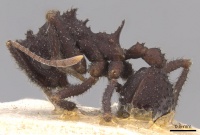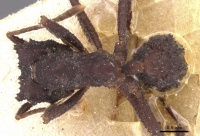Mycetomoellerius urichii
| Mycetomoellerius urichii | |
|---|---|

| |
| Scientific classification | |
| Kingdom: | Animalia |
| Phylum: | Arthropoda |
| Class: | Insecta |
| Order: | Hymenoptera |
| Family: | Formicidae |
| Subfamily: | Myrmicinae |
| Tribe: | Attini |
| Genus: | Mycetomoellerius |
| Species: | M. urichii |
| Binomial name | |
| Mycetomoellerius urichii (Forel, 1893) | |
| Synonyms | |
| |
Identification
Distribution
Latitudinal Distribution Pattern
Latitudinal Range: 11.25° to -22.41277778°.
| North Temperate |
North Subtropical |
Tropical | South Subtropical |
South Temperate |
- Source: AntMaps
Distribution based on Regional Taxon Lists
Neotropical Region: Brazil, Colombia, French Guiana, Guyana, Panama, Suriname, Trinidad and Tobago (type locality), Venezuela.
Distribution based on AntMaps
Distribution based on AntWeb specimens
Check data from AntWeb
Countries Occupied
| Number of countries occupied by this species based on AntWiki Regional Taxon Lists. In general, fewer countries occupied indicates a narrower range, while more countries indicates a more widespread species. |

|
Estimated Abundance
| Relative abundance based on number of AntMaps records per species (this species within the purple bar). Fewer records (to the left) indicates a less abundant/encountered species while more records (to the right) indicates more abundant/encountered species. |

|
Biology
|
Life History Traits
- Mean colony size: 100 (Jaffe & Villegas, 1985; Beckers et al., 1989)
- Foraging behaviour: mass recruiter (Jaffe & Villegas, 1985; Beckers et al., 1989)
Castes
Phylogeny
| Mycetomoellerius |
| ||||||||||||||||||||||||||||||||||||||||||||||||
| |||||||||||||||||||||||||||||||||||||||||||||||||
Based on Micolino et al., 2020 (selected species only).
Nomenclature
The following information is derived from Barry Bolton's Online Catalogue of the Ants of the World.
- urichii. Atta (Trachymyrmex) urichii Forel, 1893e: 601 (w.m.) TRINIDAD.
- Emery, 1894c: 222 (q.).
- Combination in Trachymyrmex: Gallardo, 1916b: 242; Wheeler, W.M. 1916d: 325.
- Combination in Mycetomoellerius: Solomon et al., 2019: 948.
- Senior synonym of fusca, marthae, panamensis, radicis: Weber, 1958b: 53.
- fusca. Atta (Trachymyrmex) urichi subsp. fusca Emery, 1894c: 222 (w.) BRAZIL. Junior synonym of urichii: Weber, 1958b: 53.
- marthae. Atta (Trachymyrmex) urichii r. marthae Forel, 1912e: 183 (w.q.) COLOMBIA. Junior synonym of urichii: Weber, 1958b: 53.
- panamensis. Trachymyrmex urichi subsp. panamensis Wheeler, W.M. 1925a: 38 (w.) PANAMA. Junior synonym of urichii: Weber, 1958b: 53.
- radicis. Trachymyrmex urichi subsp. radicis Weber, 1938b: 197 (w.) TRINIDAD. Junior synonym of urichii: Weber, 1958b: 53.
Description
Karyotype
- n = 9, 2n = 18, karyotype = 16M + 2SM (Brazil) (Barros et al., 2013) (as Mycetomoellerius fuscus).
References
- Barros, L.A.C., Aguiar, H.J.A.C., Mariano, C.S.F., Delabie, J.H.C., Pompolo, S.G. 2013. Cytogenetic characterization of the ant Trachymyrmex fuscus Emery, 1934 (Formicidae: Myrmicinae: Attini) with the description of a chromosomal polymorphism. Annales de la Société Entomologique de France 49: 367–373 (doi:10.1080/00379271.2013.856201).
- Beckers R., Goss, S., Deneubourg, J.L., Pasteels, J.M. 1989. Colony size, communication and ant foraging Strategy. Psyche 96: 239-256 (doi:10.1155/1989/94279).
- Emery, C. 1894d. Studi sulle formiche della fauna neotropica. VI-XVI. Bull. Soc. Entomol. Ital. 26: 137-241 (page 222, queen described)
- Forel, A. 1893h. Note sur les Attini. Ann. Soc. Entomol. Belg. 37: 586-607 (page 601, worker, male described)
- Gallardo, A. 1916c. Notas acerca de la hormiga Trachymyrmex pruinosus Emery. An. Mus. Nac. Hist. Nat. B. Aires 28: 241-252 (page 242, Combination in Trachymyrmex)
- Mera-Rodríguez, D., Serna, F., Sosa-Calvo, J., Lattke, J., Rabeling, C. 2020. A checklist of the non-leaf-cutting fungus-growing ants (Hymenoptera, Formicidae) from Colombia, with new biogeographic records. Check List 16, 1205–1227 (doi:10.15560/16.5.1205).
- Moura, M.N., Cardoso, D.C., Cristiano, M.P. 2020. The tight genome size of ants: diversity and evolution under ancestral state reconstruction and base composition. Zoological Journal of the Linnean Society, zlaa135 (doi:10.1093/zoolinnean/zlaa135).
- Solomon, S.E., Rabeling, C., Sosa-Calvo, J., Lopes, C.T., Rodrigues, A., Vasconcelos, H.L., Bacci Jr, M., Mueller, U.G., Schultz, T.R. 2019. The molecular phylogenetics of Trachymyrmex Forel ants and their fungal cultivars provide insights into the origin and coevolutionary history of ‘higher-attine’ ant agriculture. Systematic Entomology 44: 939-956 (doi:10.1111/syen.12370).
- Weber, N. A. 1958b. Nomenclatural changes in Trachymyrmex (Hym.: Formicidae). Entomol. News 69: 49-55 (page 53, senior synonym of fusca, marthae, panamensis and radicis)
- Wheeler, W. M. 1916f. Ants collected in Trinidad by Professor Roland Thaxter, Mr. F. W. Urich, and others. Bulletin of the Museum of Comparative Zoology 60: 323-330 (page 325, Combination in Trachymyrmex)
References based on Global Ant Biodiversity Informatics
- Boer P. 2019. Ants of Curacao, species list. Accessed on January 22 2019 at http://www.nlmieren.nl/websitepages/SPECIES%20LIST%20CURACAO.html
- Clemes Cardoso D., M. Passos Cristiano, J. Heinze, and M. G. Tavares. 2014. A nuclear DNA based phylogeny of endemic sand dune ants of the genus Mycetophylax (Emery, 1913): How morphology is reflected in molecular data. Molecular phylogenetics and Evolution 70: 378382.
- Costa-Milanez C. B., G. Lourenco-Silva, P. T. A. Castro, J. D. Majer, and S. P. Ribeiro. 2014. Are ant assemblages of Brazilian veredas characterised by location or habitat type? Braz. J. Biol. 74(1): 89-99.
- Dias N. S., R. Zanetti, M. S. Santos, J. Louzada, and J. H. C. Delabie. 2008. Interaction between forest fragments and adjacent coffee and pasture agroecosystems: responses of the ant communities (Hymenoptera, Formicidae). Iheringia, Sér. Zool., Porto Alegre, 98(1): 136-142.
- Emery C. 1894. Studi sulle formiche della fauna neotropica. VI-XVI. Bullettino della Società Entomologica Italiana 26: 137-241.
- Emery C. 1906. Studi sulle formiche della fauna neotropica. XXVI. Bullettino della Società Entomologica Italiana 37: 107-194.
- Fernández, F. and S. Sendoya. 2004. Lista de las hormigas neotropicales. Biota Colombiana Volume 5, Number 1.
- Forel A. 1911. Ameisen des Herrn Prof. v. Ihering aus Brasilien (Sao Paulo usw.) nebst einigen anderen aus Südamerika und Afrika (Hym.). Deutsche Entomologische Zeitschrift 1911: 285-312.
- Forel A. 1912. Formicides néotropiques. Part II. 3me sous-famille Myrmicinae Lep. (Attini, Dacetii, Cryptocerini). Mémoires de la Société Entomologique de Belgique. 19: 179-209.
- Franco W., N. Ladino, J. H. C. Delabie, A. Dejean, J. Orivel, M. Fichaux, S. Groc, M. Leponce, and R. M. Feitosa. 2019. First checklist of the ants (Hymenoptera: Formicidae) of French Guiana. Zootaxa 4674(5): 509-543.
- Kempf W. W. 1978. A preliminary zoogeographical analysis of a regional ant fauna in Latin America. 114. Studia Entomologica 20: 43-62.
- Kempf, W.W. 1972. Catalago abreviado das formigas da regiao Neotropical (Hym. Formicidae) Studia Entomologica 15(1-4).
- Leal, I.R. and P.S. Oliveira. 2000. Foraging ecology of attine ants in a Neotropical savanna: seasonal use of fungal substrate in the cerrado vegetation of Brazil. Insectes Sociaux 47:376-382
- Neves F. S., K. S. Queiroz-Dantas, W. D. da Rocha, and J. H. C. Delabie. 2013. Ants of Three Adjacent Habitats of a Transition Region Between the Cerrado and Caatinga Biomes: The Effects of Heterogeneity and Variation in Canopy Cover. Neotrop Entomol 42: 258268.
- Rodrigues de Souza D., E. Stingel, L. C. de Almeida, M. A. Lazarini, C. de Bortoli Munhae, A. J. Mayhe-Nunes, O. Correa Bueno, and M. Santina de C. Morini. 2010. Ant Diversity in a Sugarcane Culture without the Use of Straw Burning in Southeast, São Paulo, Brazil. American Journal of Agricultural and Biological Sciences 5 (2): 183-188.
- Rodrigues de Souza D., E. Stingel, L. C. de Almeida, M. A. Lazarini, C. de Bortoli Munhae, O. Correa Bueno, C. R. Archangelo, and M. Santina de C. Morini. 2010. Field methods for the study of ants in sugarcane plantations in Southeastern Brazil. Sci. Agric. (Piracicaba, Braz.) 67(6): 651-657.
- Santos M. S., J. N. C. Louzada, N. Dias, R. Zanetti, J. H. C. Delabie, and I. C. Nascimento. 2006. Litter ants richness (Hymenoptera, Formicidae) in remnants of a semi-deciduous forest in the Atlantic rain forest, Alto do Rio Grande region, Minas Gerais, Brazil. Iheringia, Sér. Zool., Porto Alegre, 96(1): 95-101.
- Silva F. H. O., J. H. C. Delabie, G. B. dos Santos, E. Meurer, and M. I. Marques. 2013. Mini-Winkler Extractor and Pitfall Trap as Complementary Methods to Sample Formicidae. Neotrop Entomol 42: 351358.
- Silvestre R., C. R. F. Brandão, and R. R. Silva da 2003. Grupos funcionales de hormigas: el caso de los gremios del cerrado. Pp. 113-148 in: Fernández, F. (ed.) 2003. Introducción a las hormigas de la región Neotropical. Bogotá: Instituto de Investigación de Recursos Biológicos Alexander von Humboldt, xxvi + 424 pp.
- Solomon S. E., C. Rabeling, J. Sosa-Calvo, C. Lopes, A. Rodrigues, H. L. Vasconcelos, M. Bacci, U. G. Mueller, and T. R. Schultz. 2019. The molecular phylogenetics of Trachymyrmex Forel ants and their fungal cultivars provide insights into the origin and coevolutionary history of ‘higher-attine’ ant agriculture. Systematic Entomology 44: 939–956.
- Suguituru S. S., M. Santina de Castro Morini, R. M. Feitosa, and R. Rosa da Silva. 2015. Formigas do Alto Tiete. Canal 6 Editora 458 pages
- Weber N. A. 1938. The biology of the fungus-growing ants. Part IV. Additional new forms. Part V. The Attini of Bolivia. Rev. Entomol. (Rio J.) 9: 154-206.
- Weber N. A. 1938. The food of the giant toad, Bufo marinus (L.), in Trinidad and British Guiana with special reference to the ants. Annals of the Entomological Society of America 31: 499-503.
- Weber N. A. 1945. The biology of the fungus-growing ants. Part VIII. The Trinidad, B. W. I., species. Revista de Entomologia (Rio de Janeiro) 16: 1-88.
- Weber N. A. 1958. Nomenclatural changes in Trachymyrmex (Hym.: Formicidae). Entomological News 69: 49-55.
- Weber, Neal A. 1968. Tobago Island Fungus-growing Ants (Hymenoptera: Formicidae). Entomological News. 79:141-145.
- Weber, Neal A. 1968. Tobago Island Fungus-growing Ants. Entomological News. 79(6): 141-145.
- Weber, Neil A. 1968. Tobago Island Fungus-growing Ants (Hymenoptera: Formicidae). Entomological News. 79(6):141-145.
- Wheeler W. M. 1905. The ants of the Bahamas, with a list of the known West Indian species. Bulletin of the American Museum of Natural History 21: 79-135.
- Wheeler W. M. 1916. Ants collected in British Guiana by the expedition of the American Museum of Natural History during 1911. Bulletin of the American Museum of Natural History 35: 1-14.
- Wheeler W. M. 1922. The ants of Trinidad. American Museum Novitates 45: 1-16.
- da Silva, R.R., C.R.F. Brandao, and R. Silvestre. 2004. Similarity Between Cerrado Localities in Central and Southeastern Brazil Based on the Dry Season Bait Visitors Ant Fauna. Studies on Neotropical Fauna and Environment 39(3):191-199.

